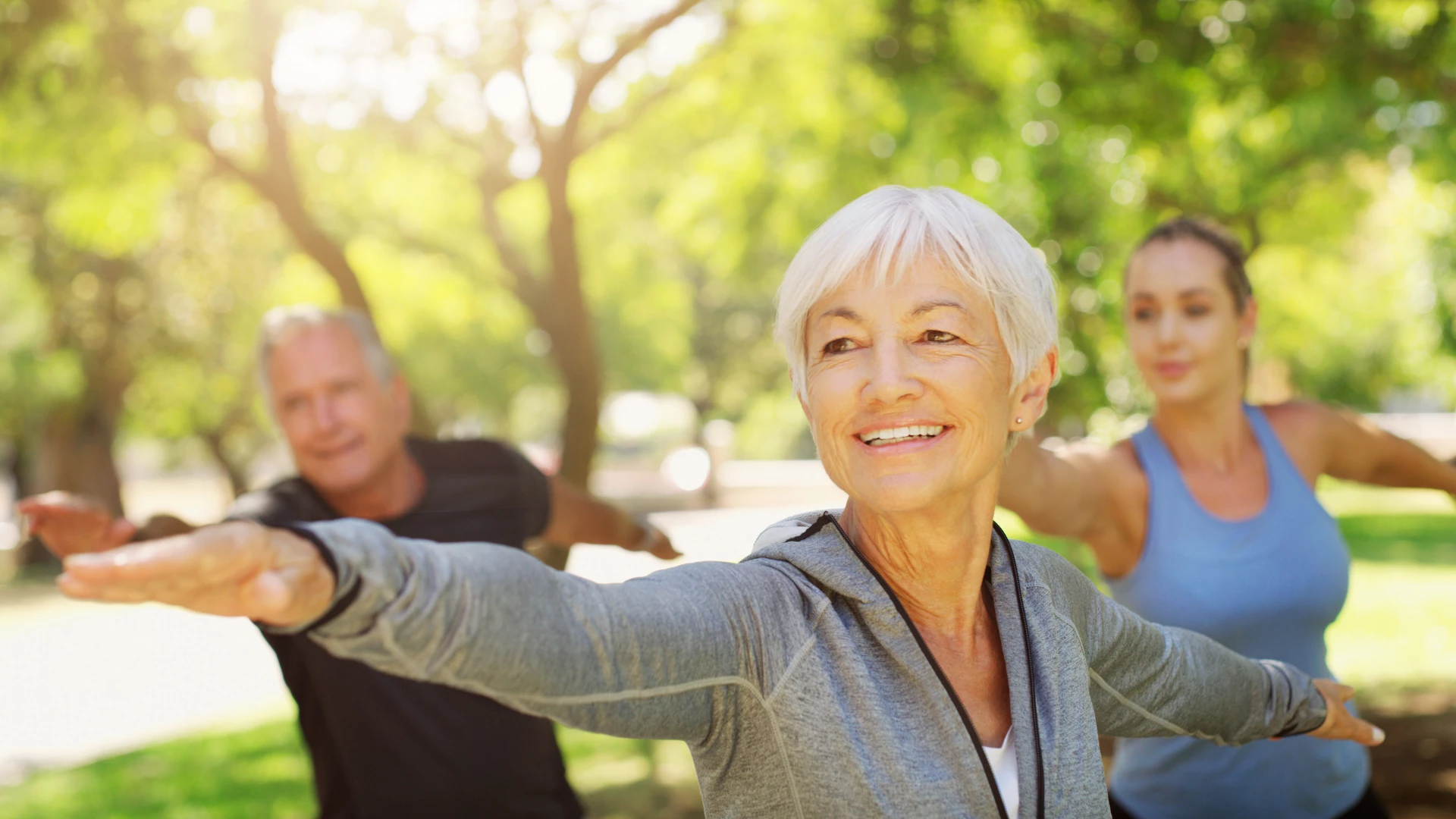Osteoporosis: 5 Ways to Keep Bones Strong

Article At A Glance
You don’t need me to convince you that exercise benefits you. Or how maintaining a base fitness level reduces your risk of injury, heart disease, and falls. I won’t tell you how regular exercise improves energy levels and sleep quality and helps fight depression. Instead, I’ll tell you that exercise is the single best conservative step you can take to protect your bones, and in this article, I include five ways to keep your bones strong to help prevent Osteoporosis.
And you want strong bones, right?!
The Bone Health and Osteoporosis Foundation estimates that one in two women and one in four men will suffer an osteoporosis-related fracture in their lifetime. For women, that number exceeds the risk of having a heart attack or stroke (which will happen to one in every five women, according to the U.S. Centers for Disease Control and Prevention). We know how to limit our risk of heart attacks and strokes (hint, skip KFC, manage stress, and walk more). But most people have no idea how to take care of their bones.
Osteoporosis: The Silent Disease
Osteoporosis has been called a “silent disease.” There aren’t multiple screens and clues that the process is happening (i.e., high blood pressure, high blood sugar, high cholesterol, and obesity). You don’t feel your bones thinning or get clear warning signs that you’re losing bone density. Instead, the condition happens insidiously over time.
It can happen to anybody. In fact, we all lose bone as we age. But for some, the condition is more likely to happen, it may happen sooner, and when it does happen, it’s more severe.
What Is Osteoporosis?

Osteoporosis and its predecessor, osteopenia, means “porous bone.” It‘s a disease where bones become brittle and frail, increasing their risk of breaking. It can be progressive and may not be discovered until you actually break a bone.
Unlike the cardiovascular system, your bones don’t spit out objective proof they are stressed. You have to look at them through imaging to see what‘s happening. (More about these tests later.)
If you discover you have low bone density and the activities you once enjoyed are now considered “dangerous,” you may feel motivated to learn more about treatment. Prevention is always better than treatment, but treatment can prevent further deterioration.
And you may ask yourself, “How did I get here?”
How Osteoporosis Develops
Bone density is maintained throughout our lives by a delicate balance of bone resorption and rebuilding. Bone thinning occurs when the body does not form enough new bone and when the body or both reabsorb too much-existing bone. Bones are living tissue with blood supply and active metabolism. They respond to your overall state of health just like any other organ. If you have a medical condition, genetics, or a lifestyle that offsets the resorption-rebuilding balance, you may increase your risk of thinning bones.
The National Osteoporosis Foundation (NOF) has a wealth of information on osteoporosis treatment and prevention. Included on their website are guidelines for getting a DEXA (dual-energy x-ray absorptiometry) scan and your risks of developing osteoporosis.
Below are some of those risks (i.e., how you got here).
- Family history of osteoporosis
- Smoking
- Vitamin D deficiency
- Excessive alcohol or caffeine consumption
- Weight loss or low body weight; small-boned body frame
- Early menopause or late onset of menstrual periods
- Physical inactivity
- Excessive exercise
- Poor nutritional habits or a history of an eating disorder
- Taking a medication (such as prednisone or some anticonvulsants) known to cause bone loss
- Low estrogen levels
- Hyperparathyroidism
- Hyperthyroidism
The good news is that good health has a simple formula: eat well, get moderate exercise and lead a healthy lifestyle.
How to Keep Your Bones Strong
1. Eat a Bone-Healthy Diet
The milk industry has capitalized on catchy slogans promoting milk’s health benefits for years. Milk may have calcium, which is good for bones, but many people don’t tolerate milk and can’t digest it well. There’s also controversy about whether cow’s milk is good for you. You can get calcium from foods and supplements other than milk.
My favorite sources of calcium are green vegetables such as kale and spinach, figs, apricots, sardines, fresh squeezed orange juice, and garbanzo beans. (Yay, hummus!) Vitamin D is necessary for calcium absorption and is found in high quantities in fish. If you are a vegetarian, you may need to supplement for the right balance of nutrients.
The International Osteoporosis Foundation recommends 1,000 mg of calcium a day for adults up to age 50 (and 1,200 a day for women over 50 and all people over 70). This is hard to do! One cup of kale has just 177 mg of calcium. Supplementation is often needed, but too much calcium is detrimental. Other supplements, like vitamin K2, have been shown to benefit bone health in multiple studies. According to the Cleveland Clinic, K1 is found in leafy greens (many of which are also rich in calcium, USDA dietary guidelines show). K2 is found in chicken liver, eggs, and certain cheeses, experts at the Cleveland Clinic say. There is not yet a recommended dosage that I know of for supplementation. And according to the Mayo Clinic, true vitamin K deficiency is rare. Talk to your doctor to see what dose and form are right for you. If you do it alone, err on the side of less.
Avoid or limit foods that carry a high dietary acid load. These foods include red or processed meats, alcohol, and processed foods, to name a few. If your diet is highly acid-producing, your body will need calcium to balance PH levels in the blood. The body leaches calcium from the bones to buffer the higher acidity and regain equilibrium. Having an occasional glass of wine won’t hurt.
2. Do Strength Training and Low-Impact Exercise
Strength training and low-impact exercises have been proven to build bone density. Studies have shown that resistance exercises, such as lifting weights, can stimulate the bone-building process. Exercise that compresses or loads your bones increases the formation of new bone cells (osteoblasts) and improves overall bone strength. Bone will adapt to the loads they are placed under, a phenomenon called Wolff’s Law. If there are compressive loads to a bone, the bone will remodel itself over time to become stronger to resist that sort of loading.

The areas of focus for your exercise program should include exercises that strengthen your postural muscles and exercises that address balance and flexibility.
Special care should be taken when bending over and with any activity involving twisting weights. Plenty of exercises strengthen the core and back without requiring you to bend and twist. (See the information below if you want more guidance on safe and targeted exercises.)
3. Lead a Healthy Lifestyle
You may think living a non-rockstar-type of lifestyle is “healthy” enough. But if you rarely get enough sleep or rest during the day, week, or month, your body will suffer. Being constantly tired or wired isn’t good for your bones. Just remember your bones are an organ and rely on a balanced environment for their health. Moderation is key to a healthy life.

4. Get Tested
A DEXA scan is a simple test. You can keep your clothes on; the process usually takes 15 minutes. If you feel you are a high risk and are under 65, you may want a screening test or peripheral test. This test measures bone density in the wrist, finger, or heel. From here, your doctor can determine if the more elaborate DEXA scan (that tests your spine and hips) is needed.
Your bone density is measured using T-scores. This compares the density of your bones to that of a 30-year-old. A score between -1 and -2.5 indicates osteopenia. Over -2.5 means osteoporosis. Your bone density test also includes a Z-score. This score compares your bone density to others your age and body size. Remember that these tests are not foolproof, and sometimes results can be misleading. This is why it is important to consider your whole health picture when considering treatment options.
5. Consider the Pros and Cons of Medication
As with most medications, those that slow the thinning of bone are not without controversy. If your doctor recommends that you start taking medication, ask her the following questions.
- How long will you be expected to take the medication?
- What will they look for in follow-up visits to ensure the medications work?
- What side effects, if any, may you expect, and how can you best mitigate them?
Oftentimes the benefits far outweigh the risks, but this is something you and your doctor can determine.
Get Help for Osteoporosis

If you think you are at risk for osteoporosis, talk to your doctor about your options for testing and treatment. A physical therapist is an exercise specialist and often the best place to start for developing a well-rounded strengthening program that is safe for your body.
As research continues to investigate the relationship between nutrition, inflammation, muscle, and bone health, we can better use this knowledge to develop strategies for early identification and treatment of muscle and bone density loss.
Do something today that your future self will thank you for.
Also, read...
Yoga for Osteoporosis: How Your Breathing Affects Your Bones
Yoga Poses Improves Both Balance and Cognitive Perfomance, Study Suggests
Book Review-Empowered Aging: Everyday Yoga Practices for Bone Health, Strength, and Balance
Related courses
Breath as Medicine: Yogic Breathing for Vital Aging
Yoga and Myofascial Release: Releasing Chronic Tension with the Bodymind Ballwork Method

Christine Carr, c-IAYT, eRYT 500 has been a physical therapist for over 20 years. In her youth, she was constantly hurting herself. This motivated her to learn how to recover from injury and heal herself, naturally. She loves to learn. Studying the human body, and mind and how they function together is exciting to her. She has a diverse academic background with experience that includes orthopedics, yoga, and functional medicine. She enjoys teaching others how to recover from injury, manage their condition, and improve their function and performance.
Christine enjoys any and all sports available in this beautiful area or kicking back with a good book in her spare time. She has recently started gardening, though she said she has much to learn!
-
- Craft, L. L., & Perna, F. M. (2003). The Benefits of Exercise for the Clinically Depressed. Primary Care Companion to The Journal of Clinical Psychiatry, 6(3), 104-111. https://doi.org/10.4088/pcc.v06n0301
- Beulens JW, Booth SL, van den Heuvel EG, Stoecklin E, Baka A, Vermeer C. The role of menaquinones (vitamin K₂) in human health. Br J Nutr. 2013 Oct;110(8):1357-68. doi: 10.1017/S0007114513001013. Epub 2013 Apr 16. PMID: 23590754.
- Hong, A. R., & Kim, S. W. (2018). Effects of Resistance Exercise on Bone Health. Endocrinology and Metabolism, 33(4), 435-444. https://doi.org/10.3803/EnM.2018.33.4.435




